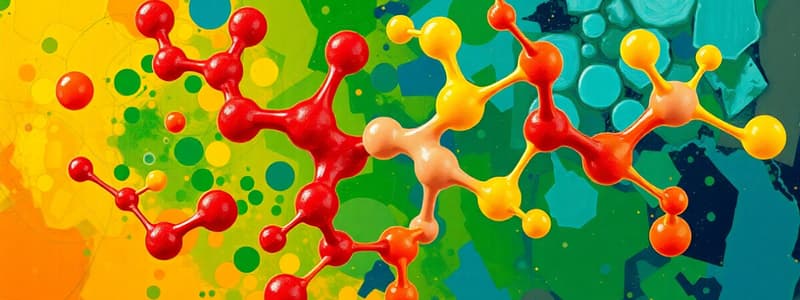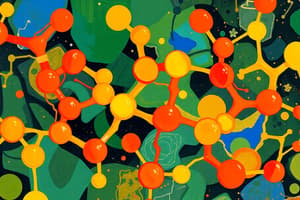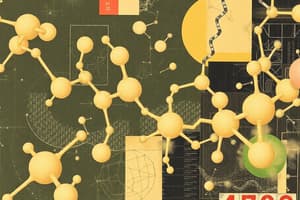Podcast
Questions and Answers
Biomolecules are ______ molecules produced by living organisms.
Biomolecules are ______ molecules produced by living organisms.
organic
Carbon, hydrogen, oxygen and ______ are the main elements of biomolecules.
Carbon, hydrogen, oxygen and ______ are the main elements of biomolecules.
nitrogen
[Blank] are molecules made from aldehydes and ketones.
[Blank] are molecules made from aldehydes and ketones.
carbohydrates
The approximate ratio of carbon to two hydrogen to one oxygen is known as ______.
The approximate ratio of carbon to two hydrogen to one oxygen is known as ______.
[Blank] is the most abundant class of biomolecules.
[Blank] is the most abundant class of biomolecules.
Carbohydrates can be classified into monosaccharides, ______, or polysaccharides.
Carbohydrates can be classified into monosaccharides, ______, or polysaccharides.
[Blank] are single unit of carbohydrates.
[Blank] are single unit of carbohydrates.
[Blank] is referred to as dextrose, the most important and most abundant monosaccharide in nature.
[Blank] is referred to as dextrose, the most important and most abundant monosaccharide in nature.
[Blank] is known as fruit sugar that is found in fruits.
[Blank] is known as fruit sugar that is found in fruits.
[Blank] are two monosaccharides that are chemically combined.
[Blank] are two monosaccharides that are chemically combined.
[Blank] are polymers containing numerous monosaccharide monomers.
[Blank] are polymers containing numerous monosaccharide monomers.
Single sugar is known as ______.
Single sugar is known as ______.
Two monosaccharides is known as ______.
Two monosaccharides is known as ______.
Three or more monosaccharides is known as ______.
Three or more monosaccharides is known as ______.
[Blank] is used for energy storage in plants.
[Blank] is used for energy storage in plants.
[Blank] is used for energy storage in animals.
[Blank] is used for energy storage in animals.
[Blank] provides structural support in plants (found in the cell wall).
[Blank] provides structural support in plants (found in the cell wall).
[Blank] is found in exoskeletons of arthropods (insects, spiders).
[Blank] is found in exoskeletons of arthropods (insects, spiders).
[Blank] are water insoluble and composed of carbon, hydrogen and oxygen.
[Blank] are water insoluble and composed of carbon, hydrogen and oxygen.
Triglycerides, phospholipids and ______ are the three major groups of lipids.
Triglycerides, phospholipids and ______ are the three major groups of lipids.
[Blank] consist of a glycerol backbone to which three fatty acids are attached.
[Blank] consist of a glycerol backbone to which three fatty acids are attached.
[Blank] are similar to triglycerides, except with one of the three fatty acids replaced with a phosphate group.
[Blank] are similar to triglycerides, except with one of the three fatty acids replaced with a phosphate group.
[Blank] contains various hydrocarbon ring structures.
[Blank] contains various hydrocarbon ring structures.
Lipids are ______ (water fearing) and do not dissolve in water!
Lipids are ______ (water fearing) and do not dissolve in water!
The bonds between all the carbons are single bons in ______ lipids.
The bonds between all the carbons are single bons in ______ lipids.
There is at least one double or triple bond between carbons present in ______ lipids.
There is at least one double or triple bond between carbons present in ______ lipids.
[Blank] are polypeptides composed of long chains of amino acids connected by peptide bonds.
[Blank] are polypeptides composed of long chains of amino acids connected by peptide bonds.
The alpha-carbon in the middle, amino group, and ______ group are the three composer parts of proteins.
The alpha-carbon in the middle, amino group, and ______ group are the three composer parts of proteins.
Each protein only differs in the ______.
Each protein only differs in the ______.
[Blank] are essential and non-essential.
[Blank] are essential and non-essential.
Amino acid ______ must be obtained in the diet.
Amino acid ______ must be obtained in the diet.
Amino acid ______ can be synthesized in the body.
Amino acid ______ can be synthesized in the body.
The ______ of amino acids in chain determine an amino acid sequence determined by gene.
The ______ of amino acids in chain determine an amino acid sequence determined by gene.
[Blank] is created when the secondary structure fold and form bonds to stabilize the structure into a unique shape.
[Blank] is created when the secondary structure fold and form bonds to stabilize the structure into a unique shape.
Unfolding a protein changes te ______.
Unfolding a protein changes te ______.
Unraveling a protein is known as ______.
Unraveling a protein is known as ______.
Nucleic acids are polymers consisting of long chains of ______.
Nucleic acids are polymers consisting of long chains of ______.
Each nucleotide is composed of a pentose sugar, phosphate group and ______ bases.
Each nucleotide is composed of a pentose sugar, phosphate group and ______ bases.
[Blank] is a double-helix molecule composed of a deoxyribose, phosphate backbone and nitrogenous bases.
[Blank] is a double-helix molecule composed of a deoxyribose, phosphate backbone and nitrogenous bases.
[Blank] contains the genetic instruction of all modern organisms.
[Blank] contains the genetic instruction of all modern organisms.
[Blank] is a single-stranded molecule composed of ribose sugar, phosphate backbone and nitrogenous bases.
[Blank] is a single-stranded molecule composed of ribose sugar, phosphate backbone and nitrogenous bases.
Flashcards
What are biomolecules?
What are biomolecules?
Organic molecules produced by living organisms, mainly composed of carbon, hydrogen, oxygen, and nitrogen.
What are carbohydrates?
What are carbohydrates?
Molecules made from aldehydes and ketones, composed of carbon, hydrogen, and oxygen.
What is a monosaccharide?
What is a monosaccharide?
Single unit of carbohydrates; e.g., glucose and fructose.
What is a disaccharide?
What is a disaccharide?
Signup and view all the flashcards
What is a polysaccharide?
What is a polysaccharide?
Signup and view all the flashcards
What is starch?
What is starch?
Signup and view all the flashcards
What is glycogen?
What is glycogen?
Signup and view all the flashcards
What is cellulose?
What is cellulose?
Signup and view all the flashcards
What is chitin?
What is chitin?
Signup and view all the flashcards
What are lipids?
What are lipids?
Signup and view all the flashcards
What are triglycerides?
What are triglycerides?
Signup and view all the flashcards
What are phospholipids?
What are phospholipids?
Signup and view all the flashcards
What is cholesterol?
What is cholesterol?
Signup and view all the flashcards
What are saturated lipids?
What are saturated lipids?
Signup and view all the flashcards
What are unsaturated lipids?
What are unsaturated lipids?
Signup and view all the flashcards
What are proteins?
What are proteins?
Signup and view all the flashcards
What are amino acids?
What are amino acids?
Signup and view all the flashcards
What are essential amino acids?
What are essential amino acids?
Signup and view all the flashcards
What are non-essential amino acids?
What are non-essential amino acids?
Signup and view all the flashcards
Protein Primary (1°) Structure
Protein Primary (1°) Structure
Signup and view all the flashcards
Protein Secondary (2°) Structure
Protein Secondary (2°) Structure
Signup and view all the flashcards
Protein Tertiary (3°) Structure
Protein Tertiary (3°) Structure
Signup and view all the flashcards
Protein Quaternary (4°) Structure
Protein Quaternary (4°) Structure
Signup and view all the flashcards
What is protein denaturation?
What is protein denaturation?
Signup and view all the flashcards
What are nucleic acids?
What are nucleic acids?
Signup and view all the flashcards
What is a nucleotide?
What is a nucleotide?
Signup and view all the flashcards
What is DNA?
What is DNA?
Signup and view all the flashcards
What is RNA?
What is RNA?
Signup and view all the flashcards
Study Notes
- Quarter 4, Weeks 3-4, are focused on biomolecules
What are Biomolecules?
- Biomolecules are organic molecules produced by living organisms
- Biomolecules mainly consist of elements carbon, hydrogen, oxygen, and nitrogen.
Four Classes of Biomolecules
- Carbohydrates
- Lipids
- Proteins
- Nucleic Acids
Objectives
- Identify and describe the categories of biomolecules.
- Illustrate the structural composition of each category of biomolecules.
- Develop awareness on the different sources and benefits of biomolecules.
Carbohydrates
- Molecules made from aldehydes and ketones
- Mainly composed of carbon, hydrogen, and oxygen atoms
- These atoms are in a ratio of one carbon to two hydrogen to one oxygen, written (CH2O).
- The most abundant class of biomolecules
- Can be classified into monosaccharides, disaccharides, or polysaccharides.
Monosaccharides
- Single unit of carbohydrates
- Glucose (referred to as dextrose) is the most important and abundant monosaccharide in nature.
- Fructose is known as fruit sugar found in fruits.
Disaccharides
- Two monosaccharides that are chemically combined
Polysaccharides
- Polymers containing numerous monosaccharide monomers
Types of Polysaccharides include
- Starch
- Used for energy storage in plants.
- Potatoes, pasta, and rice are starches.
- Provide a quick form of energy for the body.
- Glycogen
- Used for energy storage in animals.
- Cellulose
- Provides structural support in plants and are found in the cell wall
- Chitin
- Found in exoskeletons of arthropods (insects, spiders)
- Also found in cell walls of some fungi
Lipids
- Water insoluble and composed of carbon, hydrogen, and oxygen.
- Classified in three major groups (triglycerides, phospholipids, and cholesterol)
- Each class differs in terms of their structure and function.
- Lipids are hydrophobic (water fearing) and do not dissolve in water.
Types of Lipids
- Triglycerides
- Fats and oils consist of a glycerol "backbone" to which three fatty acids are attached.
- Phospholipids
- Similar to triglycerides, except one of the three fatty acids is replaced with a phosphate group.
- This phosphate group has other highly polar (hydrophilic, water-loving) entities attached.
- Cholesterol
- Contains various hydrocarbon ring structures.
Bond Types and their Effect on Lipids
- Saturated
- The bonds between all the carbons are single bonds.
- Solid at room temperature
- Mainly animal fats (bacon grease, lard)
- Unsaturated
- There is at least one double or triple bond between carbons present.
- Liquid at room temperature
- Mainly plant-based fats (olive oil, peanut oil) as well as oily fish (tuna, sardines)
Proteins
- Polypeptides composed of long chains of amino acids connected by peptide bonds.
- Composed of an alpha-carbon in the middle, with an amino group, and a carboxyl group.
- Each protein only differs in the R-group.
- Classified according to the properties of their side chains such as nonpolar, polar, and electrically charged.
- The building blocks of proteins are Amino Acids
AMINO ACIDS
- Amino acids are classified into essential and non-essential amino acids
- There are 20 common amino acids.
- These feature different structural arrangements of carbon, hydrogen, nitrogen, oxygen, and sulfur.
- Essential Amino Acids must be obtained in the diet.
- Non-essential Amino Acids can be synthesized in the body
Protein Structure & Function
- Function depends on structure and 3-D structure (twisted, folded, coiled into unique shape)
- Primary structure = Order of amino acids in chain
- amino acid sequence determined by gene (DNA)
- slight change in amino acid sequence affect protein's structure & its function
Secondary Structure of Proteins
- Is the "Local folding"
- folding is along short sections of polypeptide
- involves interaction between adjacent amino acids and H bonds between backbones (O:H)
- α-helix
- β-pleated sheet
- Fibrous proteins have only secondary structure
Tertiary Structure of Proteins
- Is "Whole molecule folding”
- created when the secondary structure folds and forms bonds to stabilize the structure into a unique shape
- determined by interactions between R groups
- Hydrophobic and Ionic Bond interactions
- anchored by disulfide bridges
- Hydrogen bonds between backbones
- Van der Waals Force (velcro)
- Globular (spherical) proteins – have a tertiary structure made if enzymes.
Quarternary Structure of Proteins
- Two or more tertiary folded peptide subunits bonded together to make a functional protein
- Hemoglobin is composed of 4 polypeptides
- Collagen is composed of 3 polypeptides
Nucleic Acids
- Polymers consisting of long chains of nucleotides.
- Each nucleotide is composed of a pentose sugar, phosphate group, and nitrogenous bases.
- Nucleotides are organic molecules,the building block of DNA and RNA.
- Consists of a five-carbon sugar, a nitrogen-containing base, and a phosphate group.
Types of Nucleic Acids
- DNA (deoxyribonucleic acid)
- Is a double-helix molecule composed of a deoxyribose, phosphate backbone and nitrogenous bases adenine, guanine, cytosine and thymine.
- Contains the genetic instructions of all modern organisms.
- RNA (ribonucleic acid)
- Is a single-stranded molecule composed of ribose sugar, phosphate backbone and nitrogenous bases adenine, uracil, cytosine and guanine.
Importance of Biomolecules:
- Carbohydrates: Energy Production and Storage, Building Macromolecules, Sparing Proteins, Assisting in Lipid Metabolism
- Lipids: Serve as Structural Components of Cell Membranes, Function as Energy Storehouses and Important Signaling Molecules
- Protein: Acting as Enzymes and Hormones, Providing for Fluid and Acid-Base Balance, Transport, Protection, Wound Healing and Tissue Regeneration and Energy Production
- Nucleic Acids: DNA or deoxyribonucleic acid: double-helix Molecule Composed Of Deoxyribose, Phosphate Backbone, Nitrogenous Bases such as Adenine, Guanine, Cytosine and Thymine
- Nucleic Acids: RNA or ribonucleic acid: Single-Stranded Molecule Composed of Ribose Sugar, Phosphate Backbone and Nitrogenous Bases such as Adenine, Uracil, Cytosine and Guanine.
Studying That Suits You
Use AI to generate personalized quizzes and flashcards to suit your learning preferences.




